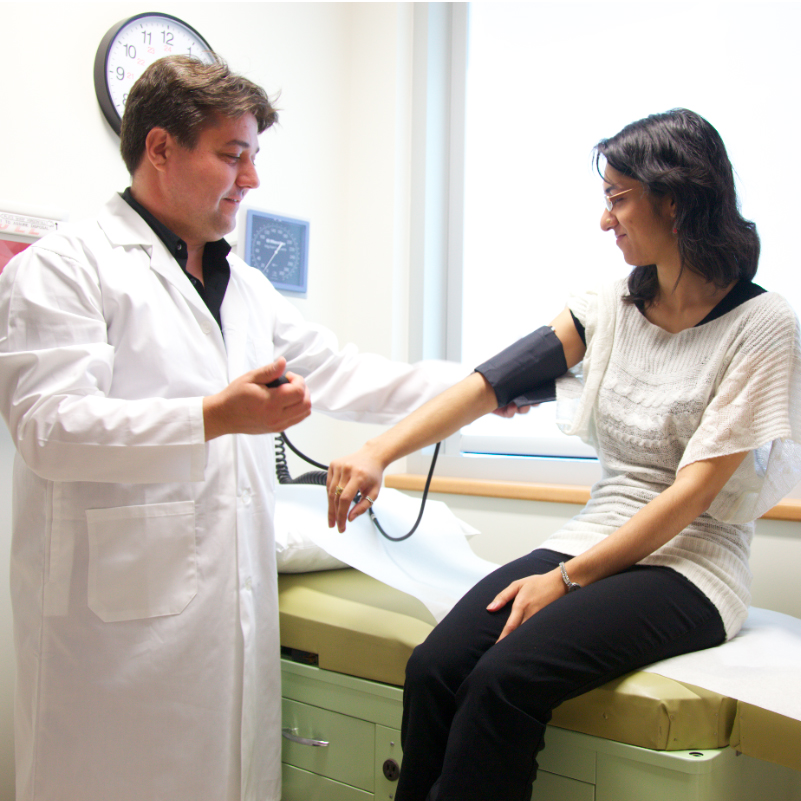Research Highlights
- Angiotensin 1-7 as a Possible Therapy for Patients with Diabetes
The renin-angiotensin system (RAS) is one of the body's primary means of regulating blood pressure, but RAS and in particular angiotensin II (ANG II) play a role in promoting the pathogenesis of both diabetic kidney disease and heart disease. For example, RAS is associated with the generation of reactive oxygen species in the kidney and mesangial matrix expansion in glomerular capillaries, contributing to diabetic nephropathy. Elevated ANG II levels also lead to cardiac hypertrophy, diastolic dysfunction and cardiac insulin resistance. ANG II is converted to Angiotensin 1-7 (ANG 1-7) via the catalytic action of angiotensin converting enzyme 2 (ACE2), and research has shown that ANG 1-7 counters some of the detrimental effects of ANG II in both organs, although the mechanism for this is far from clear. Alberta Diabetes Institute members Drs. Gavin Oudit and Gary Lopaschuk, along with postdoctoral fellows Drs. Jun Mori, Ratnadeep Basu and Vaibhav Patel and PhD students Osama Abo Alrob and Tariq Altamimi performed a pair of studies in db/db mice to better understand how ANG 1-7 was eliciting these beneficial effects. In one study the researchers administered ANG 1-7 directly into 5 month old db/db mice for 28 days and uncovered a number of pathways underlying the attenuation of diabetic nephropathy. Renal fibrosis was reduced - consistent with an observed decrease in the phosphorylation of the STAT3 (signal transducer and activator of transcription 3) pathway. Kidney mass was reduced and treatment slowed mesangial expansion while countering the reduction in albumin excretion - both characteristic of diabetic nephropathy. Treatment also reduced the generation of reactive oxygen species by attenuating NADPH oxidase activity. Even more, db/db mice receiving ANG 1-7 had lesser lipid accumulation in their kidneys and higher adipose triglyceride lipase expression which was correlated with increased SIRT1 expression and increased deacetylation (and activation) of FOXO1, the important transcription factor related to T2D. Results of their study were published in the American Journal of Physiology: Renal Physiology (306:F812-821). In a second study, db/db mice were similarly treated with ANG 1-7 and were examined for cardiac function and structure. Similar to the kidney they found that treatment resulted in reduced myocardial fibrosis and similarly reduced phosphorylation of STAT3. In addition, ANG 1-7 treatment normalized the increase in cardiac lipotoxicity observed in saline-treated animals, including TAG and ceramide levels and PKC signaling. Upregulation of SIRT1 and a resulting increase in the activation of FOXO1 were also observed, as was complete rescue of diastolic function with treatment. Additional benefits of ANG 1-7 are detailed in their publication in Circulation: Heart Failure (7:327-339, 2014). Results of the research suggest ANG 1-7 treatment represents a potential new therapy for the treatment of both diabetic nephropathy and cardiomyopathy.
- Improving Safety Evaluation of Sulfonylureas
Sulfonylurea (SU) drugs were one of the first drug treatments made available to T2D patients in the 1950s with the first of these being tolbutamide. Advancements have led to second and even third-generation SU medications that have improved the glucose-lowering efficacy of this drug class. Even though an array of newer medications now exists such as sensitizers, incretin mimetics and DPP4 inhibitors, SUs continue to be commonly prescribed. Despite their prolonged and widespread use, SUs have a long standing association with cardiovascular safety that has been based on unconvincing data and methods. While recent clinical trials (eg TOSCA.IT, CAROLINA trials) may provide more clarity about this issue, results of these studies are years away and still have study design weaknesses. Alberta Diabetes Institute member Dr Scot Simpson, along with PhD student Ahmed Abdelmoneim and the Institute's co-members Drs. Peter Senior, Peter Light and Dean Eurich recognized that researchers needed clearer direction when it came to designing future safety studies of SUs. They undertook a comprehensive overview of existing data, focusing on evidence for biological probability and past conclusions made from meta-analyses. Their research strongly suggested a number of important things, one of which was a reasonable conclusion for a plausible, biological mechanism for heart effects based on previous animal and human studies. However, conclusions drawn from meta-analyses are unreliable because observational studies have suffered from bias while randomized clinical trials (RCTs) were not specifically designed to look at cardiovascular safety and lacked the statistical power necessary to make credible inferences regarding risk. The authors suggested that a future RCT should be placebo-controlled and aimed at comparing risk differences between SUs by randomizing patients with T2D to different SU medications.
One exposure group should include either gliclazide or glimerpiride to take advantage of available data from previous observational studies. Participants in the other groups should receive glyburide as the comparison SU in order to test the theoretical, elevated risk of this SU due to its non-selectivity of KATP channel blockage in the pancreas and heart. The complete review article was published in Diabetes, Obesity and Metabolism (17:523-532, 2015).
